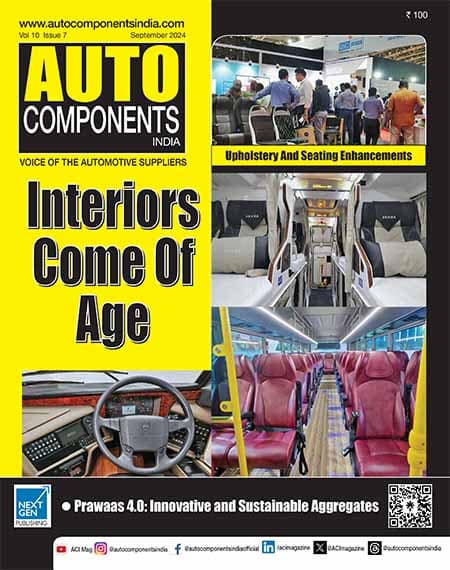J.D. Power, the Singapore-based research and consulting services, in the India Tractor Customer Service Index (CSI) Study 2018, has found that customer satisfaction with the tractor after-sales service was higher (up 28 points on a 1,000-point scale) when owners have their tractors serviced at their own premises, than when they were not offered this option, though they wanted it, by their dealer. The company, which has its presence in many parts of Asia, conducts survey and research in various fields that include automotive, information technology and finance industries in the Asia Pacific region. In an interaction with Sricharan R of Auto Components India, Yukti Arora, Practice Lead, Agriculture and Construction Equipment, J.D. Power, said, “In a rapidly transforming sector influenced by growing innovation, customer expectations of what defines an exceptional service experience keep changing.” Edited excerpts:
Q: How do the Indian agricultural and construction equipment markets fare now?
Yukti: Agriculture is the primary source of livelihood for about 58% of India’s population. Industrial development in rural India has increased household purchasing power and income stability. The government targets to double the average income of a farming household by 2022. Riding on the back of two high growth years (FY 17 and FY 18), the Indian tractor industry is projected to grow 8-10% in FY 2018-19, with positive growth momentum expected to spill over into the next fiscal period.
Some of the key elements that will help to influence the demand for tractors across India in the coming years will be financing availability, loan waivers in some cases, scarcity of farm labour, an increase in the usage of tractors in construction and other commercial activities, government’s push towards successful implementation of a system to warrant minimum support prices to the country’s farmers, a focus on increasing irrigation intensity and improving the overall infrastructure including warehousing and cold storage facilities. This, in turn, will boost the demand for tractors.
In order to improve productivity in the agriculture equipment market, farm equipment manufacturers are concentrating on integrating technologies like robotic systems, GPS, and Google Earth navigation systems in existing Indian agricultural machinery. Many AgriTech startups are working towards addressing input challenges of the industry and a lot of funding has been raised by these startups to invest in precision agriculture technologies including data- capturing devices and farm management software. Custom hiring centres (CHCs) which offer expensive farm equipment on rent to farmers – who cannot otherwise afford high-end machinery – can also play a pivotal role in boosting crop productivity and efficiency of agricultural operations.
Construction equipment (CE) sales in India grew 17% in 2017-18. Rapid urbanisation, increasing foreign investments and surging demand for customised equipment are just some of the major factors expected to boost demand for construction equipment in India in the coming years. The increasing number of public-private partnerships and government initiatives, such as smart city development projects, will also help to aid the CE market in the coming months.
India’s production of CE is expected to double over the next 5 years, given the rising domestic demand as well as, increasing exports to the countries in Southeast Asia, Africa, Middle East and China. OEMs are also harnessing digital technologies in CEs through the integration of IoT and Big Data through an advanced telematics technology. These telematics systems are widely used in the heavy equipment industries to alert users to part failure and maintenance alerts. These technologies are becoming increasingly advanced and predictive, helping maximize product uptime.
The government’s stimulants and investments to fast forward infrastructure projects primarily go towards the development of roads and highways, renewable energy and urban transport, coal mining, upgradation of airports, metro rail projects, etc. which will all have a positive impact on the CE sector. Additionally, the government is undertaking reform in its procedures and policies such as the introduction of the Real Estate (Regulation and Development) Bill, along with addressing environmental issues, forest clearances and land acquisition issues to boost development. Renting heavy equipment, as opposed to owning it, will also prove to be effective.
Q: How do you analyse and help customers in the areas they require? What is the process?
Yukti: The syndicated tractor studies help to bring the voice of the customer to the tractor manufacturers so that they can use the insights from the field to enhance product performance, quality and after-sales support to match customer expectations. Customer grievances and dissatisfaction with product quality and service support is systematically captured through a series of targeted questions in the survey. Their satisfaction rating is obtained on several products and service related attributes to ascertain the gaps in expectations and product performance or service delivery.
Q: In your recent 2018 India Tractor Customer Service Index (CSI) Study, Mahindra was ranked highest. Please share us some points on which they overtook their competitors?
Yukti: Mahindra scored the highest on customer satisfaction with both after-sales service and parts operation. Mahindra has the highest percentage of customers (68%) who say they will definitely recommend their authorised dealer to a colleague, relative or friend. They also report the highest percentage of customers (49%) who said that their tractor was returned to them cleaner after the service and has the highest percentage of customers (85%) who mention that they were provided with a service cost estimate by their authorised dealer when they contacted him for an appointment. Naturally, Mahindra has the highest proportion of customers (93%) who state that the amount they paid for service was in line with their expectations. This year’s studies also found that Mahindra has the highest proportion of customers (82%) who mention that at least 70% of the parts were available at the dealership on average when ordered. They also have the highest proportion of customers (27%) who are delighted with the quality of parts.
Q: How the study is going to benifit the consumers?
Yukti: Tractor manufacturers are working diligently based on the study insights, towards further refining the product quality and focusing on improving the product-mix, as well as streamlining their dealer service to offer unparalleled after-sales support to customers. This is reflected in the consistent increase in customer satisfaction scores observed on Overall Product and Service, as seen in our tractor studies over the last 2 consecutive years.
Q: How the tractor community gets benefited from the survey?
Yukti: The studies help manufacturers identify weaknesses in products and services and tap into rapidly changing customer requirements, to offer higher quality products and services aimed at enhancing tractor owners’ satisfaction. They also provide specific benchmark information to enable OEMs to identify best-in-class performance and understand product and service quality that resonate best with the customer, and thus design and target their offerings accordingly.
Q: Last year you said that there was a growth in the unauthorised service centres. How is it now?
Yukti: Service defection rates are continuing to increase among tractor owners who are not satisfied with the service experience at their authorised dealerships, and such customers steadily prefer unauthorised or local servicing options even within the warranty period. To manage the liquid customer expectations, the tractor industry needs to explore new dimensions of understanding and satisfying their target audiences whose experiences are being constantly shaped by their interactions across different sectors.
Q: What are the new upcoming trends in the agricultural and construction equipment market?
Yukti: Population growth, rising income levels leading to increasing consumption, and increasing exports favour the growth of agriculture and CE in India. Financial availability and incentives from the government will drive mechanisation in the coming months and years. Implementation of scientific farming practices and an increased focus on agricultural infrastructure such as irrigation, high yielding seed varieties, fertilizers, warehousing and cold storage facilities will boost farm mechanization and therefore the demand for tractors.
Increased use of tractors for non-farming activities will further propel their demand. With the tractor OEMs offering increased price discounts, undertaking aggressive marketing activities and offering a wide product range to choose from, more and more farmers will be encouraged to embrace the benefits of increased mechanization. Innovative approaches such as tractor rentals or pay-per-use model, would also significantly increase tractor demand.
Going forward, the Indian construction equipment market will continue to be driven by construction, mining and other infrastructure investments. The macro-economic situation, government policy and availability of funding will support this upsurge. With sectors such as irrigation, ports, and water conservation showing potential, it will start driving demand in the coming times. The Union Budget 2018-19 has allocated around $92 billion for the infrastructure sector. Such a frenetic pace of execution over the coming years will mean a further surge in demand for construction equipment. India is also witnessing significant interest from international investors in the infrastructure space. Besides the aforementioned indicators, addressing the CE industry’s skill development needs, clearing impediments to rent and leasing of CE, and establishing stringent quality norms and better process controls in the project implementation, would be some key imperatives for increasing CE usage in construction activities.
Q: In the study, what are the major differences you found between the first and latest?
Yukti: Customer expectations have soared over the years and their tolerance towards poor quality products and services has decreased. As customers increasingly demand convenient door-step and immediate service, service defection rates are increasing, and customers are turning towards unauthorised servicing options when they are dissatisfied with the service experience at their authorised dealers.
The consistency of product and service delivery is not solely sufficient to deliver growth and customer loyalty. An accompanying need to proactively meet ever-growing customer expectations is also required. With increased information availability and product choices abound across HP segments, cross-shopping rates have gone up, pushing down the proportion of predetermined buyers.
Customers no longer rely solely on word-of-mouth for their new tractor purchase. Dealers thus, need to focus on building their value propositions to attract these new-age tractor buyers. They need to emphasize not only on the product’s functional benefits but also on meeting unique customer requirements pertaining to their nature of the application, type of land or soil, a variety of implements being used as well as, specific needs of individual demographic segments.
Industrial development in rural India has increased household purchasing power and income stability. As rural income rises, rural consumption is shifting from necessities to buying discretionary goods and lifestyle products, including mobile phones, television sets, two-wheelers and cars. Rural consumers have been trading up, and their consumption basket is beginning to mirror that of the urban consumer. Even though rural customers remain price-conscious buyers, low prices alone are no longer the driving force behind their new tractor purchase. These customers are increasingly seeking better utility, improved features, greater comfort and easier maintenance from their new tractors. With experiences seeping over from one industry to another, they exert pressure on tractor manufacturers and dealers to rethink their strategies and tailor their offerings to transform the customer experiences and maintain their competitiveness in a fast-changing market.
Q: Going forward, what will be the new aspects that you will include in the next survey?
Yukti: We begin each study with a review of the previous year so that we can provide perspectives and insights that are trending and relevant to the industry and for the consumer. We are still in the process of finalizing our 2019 studies.
Box:
Mahindra leads
The 2018 India Tractor Customer Service Index (CSI) Study is based on responses from 3,835 tractor owners across 14 states. The study, now in its fourth year, was fielded from January 2018 to May 2018 and includes owners who purchased a new tractor between January 2016 and May 2017 from an authorised dealership. Mahindra ranks highest in satisfaction with the after-sales service experience with a score of 831, a 30-point improvement from 2017. Mahindra Swaraj (825) ranks second and John Deere (822) ranks third among the eight brands included in the study.
Highlights of the study
58% of tractor owners received offers from their dealers to service their tractors at the owner’s premises; only 41% accepted that offer.
More than one-third (34%) of customers opting for the door-step service had a better-than-expected overall service experience aginst those who would have liked but were not offered the service (20%).
62% of tractor owners say they “definitely would” revisit their authorized dealers for maintenance or repair work, compared with 53% in 2017.
Satisfaction with service increases when tractor owners receive proactive reminders from their dealers about routine maintenance appointments, compared to when customers have to visit the dealer for arranging their service or repair work.
However, only 1 in 5 tractor owners was contacted by the dealer to arrange for the service/ repair visit.
















